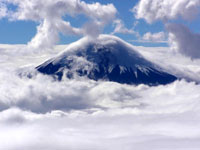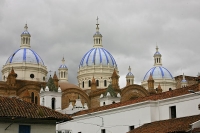As a travel destination, Ecuador is most famous for its ecological wealth. Indeed, the country's most notable tourist attraction is the Galapagos island chain, once the scientific playground of Charles Darwin. On this small archipelago of volcanic islands, weird and wonderful animals like the giant tortoise and marine iguana can be observed. Tourism on the Galapagos is strictly controlled to preserve the famous eco-system.Other breathtaking natural wonders in Ecuador include the many volcanoes, particularly Cotopaxi, which is one of the highest active volcanoes in the world, and home to one of the few equatorial glaciers in the world. The Amazon rainforest attracts many adventurous travellers, with the town of Tena the most common launching point for jungle treks. Nature lovers will appreciate the Cuyabeno Wildlife Reserve as well. It lies in the Andean foothills.Those wanting to experience the scenic Ecuadorian coastline should to head to the southern coast, where numerous picturesque beach resorts can be found. The most popular of these is the pretty town of Montanita.The capital, Quito, is the transport hub of the country and attracts tourists in its own right, thanks to its colonial architecture, colourful markets, and Cotopaxi looming in the background. Cuenca is also a very attractive town and a hotspot on Ecuador's tourist circuit.
The small town of Banos is a holiday favourite for its hot springs. Framed by majestic mountains and volcanoes, it serves as a gateway to the Amazon rainforest. Situated on the slopes of the active Tungurahua volcano, Banos is also on constant alert for signs of activity from "The Black Giant". The town is popular with Ecuadorian and international travellers alike, as a place to relax in unspoilt, peaceful surroundings. The best known of Banos' therapeutic hot baths is the Piscina de La Virgen, which is next to a waterfall. For the traveller looking for more holiday action, there are numerous activities, including horse riding, hiking, and mountain biking. It is also possible to organise trips to the Oriente, the forests of the Amazon Basin, where travellers can see wildlife, visit indigenous communities deep in the jungle, and experience life in the isolated far reaches of the country. There are many bars and restaurants throughout the town, often with live folk music.Banos is also home to Ecuador's most famous candy, taffy, which is made from sugarcane. Hanging from hooks in the doorframes of almost every shop, it is an integral part of the Banos landscape.

Parque Nacional Cotopaxi is Ecuador's most visited National Park, with one of the highest active volcanoes in the world at its centre. At 19,350ft (5,900m) above sea level, Volcán Cotopaxi offers excellent hiking and climbing opportunities along with a small museum, a llama herd and camping and picnicking facilities. There is also a good chance of spotting condors and deer. An overnight mountain hut on the snow line is available for those wishing to climb the volcano. The recommended months for climbing Volcán Cotopaxi are December through April. However, travellers should always pay close attention to any alerts or warnings issued by authorities regarding volcanic activity. Those not interested in climbing the volcano will find picturesque walking trails around the lake at the bottom of the mountain, and there is a restaurant nearby for refreshment.
Address : Main park entrance is three miles (5km) north of Lasso
Transport : Buses go to the park entrance (journey time is 1.5 hours), but it is better to arrange a guided trip from Quito. Pick-up trucks at the entrance are also available to take visitors to the car parking lot.

The Spanish founded the charming city of Cuenca in 1557. Despite being Ecuador's third largest city, it is quaint and pretty, and a favourite for photographers, with its cobblestone streets and 16th-Century buildings. It is a good idea to spend a few days relaxing in this special place, where colourful Ecuadorian culture meets old-world colonial style. There are a number of museums and churches to see, as well as bustling plazas and markets that can be visited during a leisurely ramble around town. The nearby fortress of Ingapirca is a popular excursion. Located just outside Cuenca and in a town of the same name, the fortress' ruins constitute Ecuador's only major Inca site.
El Mitad del Mundo (The Middle of the World) is a purpose-built complex of museums and shops that was constructed to mark the equator, the line that gives the country its name. The 96-foot (30m) high Equator Monument is the focus of the square, topped by a brass sphere representing the world. A painted line stretches out on either side of the monument marking the equator that divides the world, and the complex into northern and southern hemispheres. A set of weighting scales also lie on the square and illustrate the fact that visitors lose a bit of weight of the equator, as they're subject to a lesser force of gravitational attraction than usual. An anthropological museum has interesting displays of Ecuador's indigenous populations and their customs, and there is a scenic lookout at the top as well as a planeterium. Buses leave regularly from Quito for El Mitad del Mundo. There is a small admission price for the complex.
Address : The site is 12 miles (20km) from Quito
Website : www.mitaddelmundo.com
Ecuador is famous for its colourful, indigenous markets, and the best known of these is the market at Otavalo. It dates back to pre-Incan times, when jungle products were brought up from the lowlands to be traded for highland goods. Every Saturday, visitors will find a wonderful sprawling mix of rich colour, smells, and the sounds of energetic bargaining, an essential part of trade and an art in itself. Spread over three plazas and the surrounding streets, thousands of local otavaleños in striking traditional dress sit among their wares, doing hard business with tourists and locals alike. The Plaza de los Ponchos is the main area for crafts like woollen blankets, bright ponchos and jerseys, colourful bags and woven tapestries. It is possible to buy almost anything from fresh fruit and rain sticks, to jewellery and dried lentils. The noisy animal market commences first thing in the morning. Located on the edge of town, locals visit it to buy and sell cows, pigs, horses and llamas, with much haggling over prices.
The Plaza de la Independencia has always been the heart of Quito. As the hub of the old centre, it is the best place to sit, enjoy a meal, and people-watch. The City Hall, the cathedral, the Archbishop's Palace and the Government's Palace are all located around the square. The cathedral is the oldest church in South America, and is one of the city's most impressive historical and architectural sites. Both the Government Palace and the cathedral were scenes of shocking murders. In 1875, President García Moreno was murdered by machete, and in 1877 the Bishop of Quito was poisoned during a Good Friday Mass. But despite this gory history, the Plaza Grande is now the happy, atmospheric heart of Quito and should be the first stop for travellers.
The Iglesia de San Francisco is a peaceful place, without the shady benches full of people and the business of Plaza de la Independencia. Inside, visitors will find chapels gilded in gold, splendid altars and many religious paintings and carvings produced by the Quito School. Its monastery holds some priceless examples of Spanish sculpture and art. It is one of the biggest religious compounds in South America, with seven courtyards and buildings stretching behind the church. These only become evident once the visitor has ventured through the stone doorway of the main entrance. The Iglesia de San Francisco is arguably Quito's greatest tourist attraction and a must-see for travellers in the city.

Travel Guide powered by Word Travels, copyright © 2023 Globe Media Ltd. By its very nature information in this travel guide is subject to change at short notice and travellers are urged to verify information on which they're relying with the relevant authorities. Neither Globe Media Ltd nor Travel Vogue can accept any responsibility for any loss or inconvenience to any person as a result of information contained above.